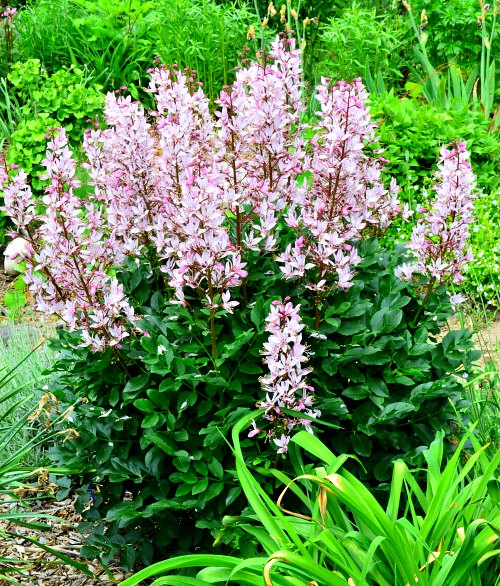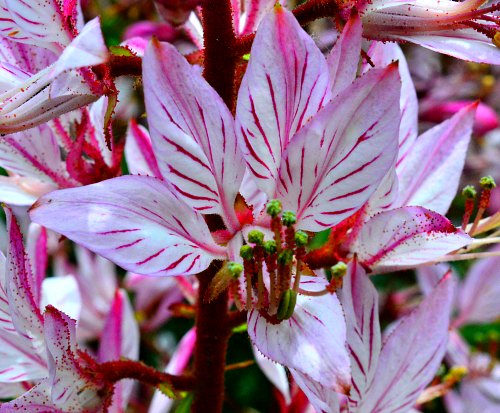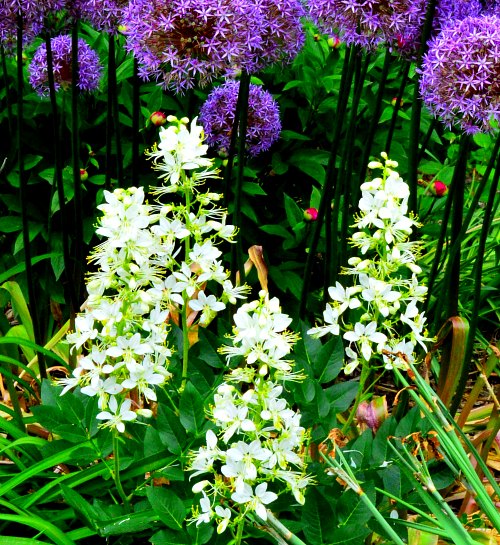Plant of the Month for August, 2017

(dik-TAM-nus AL-bus)
General Information:
Dictamnus albus always makes a big splash in the garden when it is flowering and even when it is not flowering it is a very interesting plant with good leaf structure. Even the star-shaped seed heads are interesting. So why is this plant not seen more in gardens? It is very slow growing and I think it costs nurseries too much to get it to a saleable size. Fashions have changed and this fantastic plant has been left behind in favor of more modern plants. That is a real shame since few garden plants will match the presence of a mature Dictamnus.

Dictamnus albus ‘Purpureus’: photo by Robert Pavlis
The most common name is gas plant, but some people also call it burning bush, dittany, and fraxinella. The name gas plant refers to the of fragrant, flammable oils produced both during flowering, and while it produces seeds. The fragrance is lemony and quite pleasant. If you touch the plant, you will feel the oils produced. Some, consider this to be the burning bush referred to in the bible.
Is the gas plant really flammable? Have a look at this video.
https://www.youtube.com/watch?v=OH7u4xFmpP0
Before you go and touch this plant you should be aware that it causes phytophotodermatitis (ie skin reaction) for some people where exposure to sun produces blisters. I don’t have this problem and most people don't.

Dictamnus albus ‘Purpureus’: photo by Robert Pavlis
The gas plant has a long, deep tap root which makes it very drought tolerant but also difficult to divide or move. It is best to leave the plant where it is, and grow a new one from seeds. But even this can be a bit tricky. When the seeds are ripe, they are shot out of the seed capsule as soon as you touch them. It is best to bag seed heads and wait until they drop into the bag.
Seedlings grow slowly, but are not difficult to raise. The plants are quite tough and should flower in 3-4 years. Once established, it will last a very long time.

Dictamnus albus 'Alba': photo by Robert Pavlis
Available in three main colours, pink with stripes (D. albus ‘Purpureus’), white (D. albus ‘Alba’) and a much less common red (D. albus ‘Rubra’). I looked for a picture on the internet for rubra and could not find one. Several nurseries sell a so-called rubra, but the pictures are clearly that of Purpureaus. Does a red one really exist?
Website administrator's comment: The Royal Horticultural Society is the primary reference used by ORG&HPS for confirming the name of cultivars. RHS lists D. albus var. albus and D. albus var. purpureus indicating they are varieties, not cultivars. In addition, they specify that D. albus 'Rubra' is a synonym for D. albus var. purpureus. See RHS database
Life Cycle: perennial
Height: Plant is 60cm (2 ft) tall with the flower spike adding 30 cm (1 ft)
Bloom Time: Mid summer
Natural Range: Europe, North Africa and much of Asia
Habitat: open woodland
Synonyms: Dictamnus fraxinella, Dictamnus caucasicus
Cultivation:
Light: full sun
Soil: fertile and humusy – but not fussy
Water: drought tolerant once established
USDA Hardiness Zone: 3 – 9, prefers cool climates
Propagation: seed, division with care
Seedex availability (ORG&HPS annual Seed Exchange): usually
